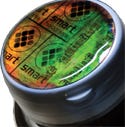Hologram-Based Sensor Offers Insight into Continuous-Monitoring Applications
Wireless data collected directly from patients during normal physical activities could enable the development of better knee implants
May 11, 2008
Originally Published MPMN May 2008
BREAKTHROUGHS
Hologram-Based Sensor Offers Insight into Continuous-Monitoring Applications
|
While trying to improve the resolution of electron microscopes, Dennis Gabor recorded an optical interference pattern between light waves. Combining the Greek words holos, meaning whole, and gramma, meaning message, the British physicist called his creation a hologram. Now, a company’s hologram-based sensor can provide a “whole message” of a patient’s condition when integrated into continuous-monitoring and diagnostic devices.
Lead inventor Chris Lowe, director of the Institute of Biotechnology at the UK’s University of Cambridge, was looking for an optical sensor technology. He came up with an approach using a hologram as a readout from a biosensor, according to John Pritchard, chief technical officer of Smart Holograms.
Smart Holograms makes the hydrogels and the specific reagentry in them. Hydrogels respond to their local environment, and, in these smart holograms, are used as the sensing component to detect chemical imbalances or changes in a patient’s blood, for example. “The skill sets we brought in terms of developing Chris’s idea further are the polymer chemistry and synthetic chemistry we use to put the right specific binder into the polymer backbone [of a hydrogel],” Pritchard says. Engineering specific receptors in the hydrogels enables them to react to a variety of different compounds ranging from small molecules, such as sodium, potassium, and calcium, to glucose, which Pritchard says is likely the sensor’s lead medical application.
Potential applications are focused primarily on continuous monitoring of diabetic or intensive-care patients. The sensor is not intended to replace the standard fingerstick method of blood-glucose testing altogether, Pritchard says. However, providing continuous blood-glucose monitoring of ICU patients can require as many as 20 fingersticks in a day, compared with the 4–7 tests per day doctors recommend average diabetic patients self-perform. The hologram sensor, on the other hand, monitors glucose levels continuously; the system can deliver results every three minutes to provide a more complete view of a patient’s blood-glucose levels as they rise or fall compared with the data of 20 discrete samples.
Data presentation depends on how the sensor is packaged and used in a device. Pritchard suggests that there are several potential display options manufacturers could explore, including color change of a visual image. “If you want to monitor something on a continuous basis, you’ll see a change in the color where you can follow the peak wavelength change if you want a number,” he says. In the home-testing market, offering patients a digital or graphic readout can eliminate confusion associated with reading test results. Smart Holograms also envisions using the sensor for diagnostic tests.
Smart Holograms, Cambridge, UK
www.smartholograms.com
Copyright ©2008 Medical Product Manufacturing News
You May Also Like


.png?width=300&auto=webp&quality=80&disable=upscale)
